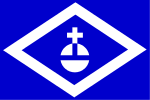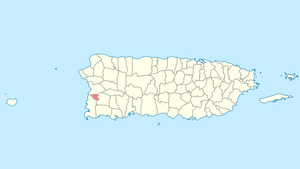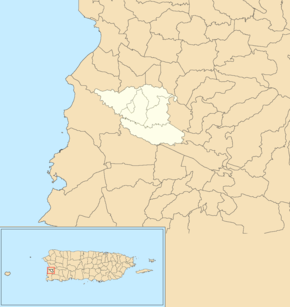Hormigueros, Puerto Rico
Hormigueros (Spanish pronunciation: [oɾmiˈɣeɾos]) is a municipality of Puerto Rico, United Stated, located in the western region of the island, northeast of Cabo Rojo; northwest of San Germán; and south of Mayagüez. Hormigueros is spread over 5 wards and Hormigueros Pueblo (the downtown area and the administrative center). It is part of the Mayagüez Metropolitan Statistical Area.
Hormigueros Municipio Autónomo de Hormigueros | |
|---|---|
Municipality | |
Basílica Menor de la Virgen de Monserrate | |
 Flag | |
| Nicknames: "El Pueblo de Nuestra Señora de la Monserrate", "El Pueblo del Milagro", "Los Peregrinos", "Corazón del Oeste" | |
| Anthem: "Sobre un verde valle de mi linda Borinquén" | |
 Map of Puerto Rico highlighting Hormigueros Municipality | |
| Coordinates: 18°08′23″N 67°07′39″W | |
| Commonwealth | |
| Founded | 1874 |
| Founded by | Giraldo González de la Renta |
| Seat | Edificio Modesta Díaz Segarra |
| Wards | |
| Government | |
| • Mayor | Pedro García Figueroa (Partido Popular Democrático) |
| • Senatorial dist. | 4 - Mayagüez |
| • Representative dist. | 20 |
| Area | |
| • Total | 11 sq mi (29 km2) |
| • Land | 11 sq mi (29 km2) |
| • Water | 0 sq mi (0 km2) |
| Population (2010) | |
| • Total | 17,250 |
| • Density | 1,500/sq mi (590/km2) |
| Demonym(s) | Hormiguereños |
| Time zone | UTC−4 (AST) |
| ZIP Code | 00660 |
| Area code(s) | 787/939 |
| Major routes | |
History
The region of what is now Hormigueros belonged to the Guaynia region, located on the southwest portion of Puerto Rico. Archaeological findings have established that there were tribes already settled in the region around 820 BC.
During the Spanish colonization at the beginning of the 16th century, European colonizers settled in the area. A coffin found underground the basilica was tested in laboratories and was dated prior to 1600. Historians also mention the Horomico river as one of the main sources of gold during the rush of the era.[1] In 1692, the settlement that would become the town of Hormigueros was first established as a village of San Germán. It was founded by Giraldo González de la Renta sometimes spelled Geraldo).[2]
After its initial establishment, Hormigueros belonged to the municipality of San Germán.[2] From 1863 to 1873, residents of Hormigueros made formal petitions to be separated from San Germán and be declared an independent municipality. They were finally granted their independence as a municipality on April 1, 1874, being its first mayor Narciso Oller Serra.
However, after the American invasion of 1898, Hormigueros was annexed this time to the town of Mayagüez. The annexation was ordered by Guy V. Henry, but according to Adolfo de Hostos, it was a town's petition.[3] In 1912, they were granted their independence once again, although there were attempts to annex them again during 1928–29.
Folklore
There is folklore about the town's founder, an explanation of why the church in the town, Basílica Menor de la Virgen de Monserrate, became so important. The legend has to do with the townspeople aiding Geraldo in finding his eight-year-old daughter, "with eyes as blue as the turquoise skies", when she disappeared. When his daughter was found 15 days later she was unharmed, not hungry, and unafraid and happily explained that a black woman had helped her. Geraldo and the townspeople imagined it was the Virgin of Montserrat and Geraldo said that for having helped his daughter she would be venerated for all ages. Many people heard of the tale and began praying for miracles at the place. Many pilgrimages have been made to the church, even as early as in the 17th century.[4] It had not been the first time Geraldo had experienced a miracle at the location where the church would be built. The first miracle was when a savage bull was going to attack him but when he prayed the bull bent its knees, bowed its head to the ground, and didn't attack.[5] Some versions of the story of the bull that would kill Geraldo state the bull's legs actually broke and thus was unable to charge at him.[6] Since then, many Catholics perform penitence by walking the steps to the church on their knees.[7]
Hurricane Maria
Hurricane Maria on September 20, 2017 triggered landslides in Hormigueros with the significant amount of rainfall.[8][9]
Symbols
Flag
The town's flag is based on the towns shield. It consists of a blue cloth with a horizontal white rhombus. Superposed on the white rhombus is another blue rhombus with a white globe outlined in blue with a cross. The globe with the cross symbolises royalty and represents Christ's domain over the world. This symbol is a traditional attribute to the Virgin of Montserrat.[2]
Coat of arms
The town's shield is formed by a blue rhombus, with silver-plated edge. On the blue bottom there's a green hill which is a representation of Our Lady of Monserrate de Hormigueros Sanctuary, with its silver stairway. The border has symmetrical black dots, on guard. On the top of the shield resides a crown formed by a wall, with three towers that have blue doors and windows. The joints of the stones are filled with blue lines. The shield is surrounded by two chains that begin at the crown and finish under the bottom part of the shield with the last links broken.[2]
Name
The name of Hormigueros means "anthill" in English. The town possibly derives its name from three concepts. The first one refers to the crowds that gathered at the Basilica Menor on September 8 to honor the Virgin of Montserrat. The second refers to the topographic formation of the town which consists of countless hills resembling "anthills" or mogotes, reason why it was called "Valle del Hormiguero" or "Anthill Valley". Third, it is possible that the name was originated from a Taíno word: Horomico, which means "río de oro" or "river of gold" due to the importance of the rivers in the area during the gold rush of the Spanish colonization.[2]
Geography
The municipality of Hormigueros can be divided in three areas: the northern mountainous region that covers one fourth of the town, with hills of relative height; a semi-mountainous region that extends from east to west covering downtown Hormigueros; and the flat, valley-like region that extends towards the south covering 5.6 square miles.[2]
Climate
The climate conditions of Hormigueros are hot and humid. The average temperature is 72 to 79 °F (22 to 26 °C).
Barrios

Like all municipalities of Puerto Rico, Hormigueros is subdivided into barrios. The municipal buildings, central square and large Catholic church are located in a small barrio referred to as "el pueblo".[10][11][12][13]
These residential areas are located outside Hormigueros downtown:
- Buenaventura
- San Romualdo Norte
- San Romualdo Sur
- Valle Hermoso Norte
- Valle Hermoso Sur
Sectors
Barrios (which are like minor civil divisions)[14] in turn are further subdivided into smaller local populated place areas/units called sectores (sectors in English). The types of sectores may vary, from normally sector to urbanización to reparto to barriada to residencial, among others.[15][16][17]
Culture
Festivals and events
Hormigueros celebrates its patron saint festival in September. The Fiestas Patronales Virgen de la Monserrate is a religious and cultural celebration that generally features parades, games, artisans, amusement rides, regional food, and live entertainment.[2]
Other festivals and events celebrated in Hormigueros include:
- Three Kings day Festival – January
- Evening of poetry and music dedicated to love and friendship – February
- Cultural meet – March
- Town anniversary – April
- Celebration honoring Ruiz Belvis – May
- Evening of poetry and music dedicated to mothers – May
- Evening of poetry and music dedicated to fathers – June
- Youth Festival – July
- Patron Saint’s Festival queen selection – August
- Segundo Ruiz Belvis Marathon – September
- Puerto Rican Culture day – November
- Lighting of the Christmas tree – The first Saturday after Thanksgiving
- Caroling (Aguinaldos) – December
Tourism
Despite its small size, Hormigueros does have several attractions for visitors including:[2]
- Birán Recreational Farm
- Central Eureka (sugar refinery)
- Basilica Menor de la Virgen de Monserrate
Economy
The economy of Hormigueros is still developing. In the 1980s and '90s Allergan, Inc. (a pharmaceutical company) had a subsidiary established in town boosting the economic development of Hormigueros. However, after Allergan left no other private industry has opened operations in Hormigueros. On the other hand, Hormigueros does provide abundant land, talent and accessibility for an economic development and expansion. Not far away there are two regional airports: Eugenio María de Hostos Airport at Mayagüez and Mercedita Airport at Ponce. In addition, there is Rafael Hernández International Airport at Aguadilla. All three airports lie within 30 miles approximately.[2]
Demographics
| Historical population | |||
|---|---|---|---|
| Census | Pop. | %± | |
| 1900 | 3,215 | — | |
| 1910 | 3,887 | 20.9% | |
| 1920 | 4,584 | 17.9% | |
| 1930 | 4,872 | 6.3% | |
| 1940 | 6,098 | 25.2% | |
| 1950 | 6,916 | 13.4% | |
| 1960 | 7,153 | 3.4% | |
| 1970 | 10,827 | 51.4% | |
| 1980 | 14,030 | 29.6% | |
| 1990 | 15,212 | 8.4% | |
| 2000 | 16,614 | 9.2% | |
| 2010 | 17,250 | 3.8% | |
| U.S. Decennial Census[20] 1899 (shown as 1900)[21] 1910-1930[22] 1930-1950[23] 1960-2000[24] 2010[12] | |||
| Race - Hormigueros, Puerto Rico - 2000 Census[25] | ||
|---|---|---|
| Race | Population | % of Total |
| White | 14,283 | 86.0% |
| Black/African American | 811 | 4.9% |
| American Indian and Alaska Native | 31 | 0.2% |
| Asian | 21 | 0.1% |
| Native Hawaiian/Pacific Islander | 4 | 0.0% |
| Some other race | 1,063 | 6.4% |
| Two or more races | 401 | 2.4% |
Hormigueros is a small municipality is one of the least populated. The population, according to the 2000 census, was 16,614 with a population density of 1,510.3 people per square mile (580.9/km2). Since the 1950s, the population has more than doubled. According to the 1950 census, there were 6,916 people living in Hormigueros.
Statistics taken from the 2000 census shows that 86.0% of Hormiguereños self-identify as Spanish or white origin, 4.9% as black, 0.2% as indigenous etc.
Government
The city belongs to the Puerto Rico Senatorial district IV, which is represented by two Senators. In 2012, Gilberto Rodríguez and María Teresa González were elected as District Senators.[26]
Education
Hormigueros boasts several public and private schools within its territory. Public education is handled by the Puerto Rico Department of Education, specifically the Mayaguez Local Educational Agency (LEA).
The local schools are: Elementary Schools
- Escuela Elemental Nueva
Middle Schools
- Ramon Rodríguez Diaz
High Schools
- Segundo Ruiz Belvis
Second Unit (Elementary and Middle)
- Alfredo Dorrington Farinacci
Higher Education
At the same time, most of the population (21-35) has either a bachelor or a higher degree, making the town one of the most talented ones in the Island of Puerto Rico.
Transportation
Puerto Rico Highway 2 provides access to Hormigueros from the nearby city of Mayagüez, or from Ponce. The rest of the roads in the town are mostly rural.
It has a public transportation system consisting of public cars. Taxis are also available around the town.
There are 16 bridges in Hormigueros.[27]
See also
- List of Puerto Ricans
- History of Puerto Rico
- National Register of Historic Places listings in Hormigueros, Puerto Rico
- Did you know-Puerto Rico?
- Latin American miracles
References
- "Hormigueros". Nueva Isla (in Spanish). SG Communications. Archived from the original on 2019-03-06. Retrieved 2019-03-03.
- Hormigueros: History and Founding. Archived 2019-01-12 at the Wayback Machine Encyclopedia Puerto Rico. Retrieved 21 October 2012.
- "Hormigueros" (in Spanish). Municipality of Hormigueros. Archived from the original on 2009-03-24. Retrieved 2009-03-30.
- "Selección de Leyendas puertorriqueñas". UFDC (in Spanish). Archived from the original on 2019-03-04. Retrieved 2019-03-04.
- Ramírez-Rivera, José (1979). 1929- Selección de Leyendas puertorriqueñas por Cayetano Coll y Toste ; adaptación y versión moderna de José Ramírez Rivera ; [dibujos, Janet Slemko, Brad Klein] (in Spanish) (5th ed.). Mayagüez, P.R.: Ediciones Libero. pp. 92–94. ISBN 978-0-9601700-2-9.
- Hermandad de Artistas Gráficos de Puerto Rico (1998). Puerto Rico--arte e identidad (in Spanish). La Editorial, UPR. pp. 96–. ISBN 978-0-8477-0223-7.
- LaBrucherie, Roger (1984). Images of Puerto Rico. El Centro, Calif., USA: Imágenes Press. p. 27.
- "Preliminary Locations of Landslide Impacts from Hurricane Maria, Puerto Rico". USGS Landslide Hazards Program. USGS. Archived from the original on 2019-03-03. Retrieved 2019-03-03.
- "Preliminary Locations of Landslide Impacts from Hurricane Maria, Puerto Rico" (PDF). USGS Landslide Hazards Program. USGS. Archived (PDF) from the original on 2019-03-03. Retrieved 2019-03-03.
- Picó, Rafael; Buitrago de Santiago, Zayda; Berrios, Hector H. (1969). Nueva geografía de Puerto Rico: física, económica, y social, por Rafael Picó. Con la colaboración de Zayda Buitrago de Santiago y Héctor H. Berrios. San Juan Editorial Universitaria, Universidad de Puerto Rico,1969. Archived from the original on 2018-12-26. Retrieved 2019-01-03.
- Gwillim Law (20 May 2015). Administrative Subdivisions of Countries: A Comprehensive World Reference, 1900 through 1998. McFarland. p. 300. ISBN 978-1-4766-0447-3. Retrieved 25 December 2018.
- Puerto Rico:2010:population and housing unit counts.pdf (PDF). U.S. Dept. of Commerce Economics and Statistics Administration U.S. Census Bureau. 2010. Archived (PDF) from the original on 2017-02-20. Retrieved 2019-01-03.
- "Map of Hormigueros at the Wayback Machine" (PDF). Archived from the original (PDF) on 2018-03-24. Retrieved 2018-12-29.
- "US Census Barrio-Pueblo definition". factfinder.com. US Census. Archived from the original on 13 May 2017. Retrieved 5 January 2019.
- "Agencia: Oficina del Coordinador General para el Financiamiento Socioeconómico y la Autogestión (Proposed 2016 Budget)". Puerto Rico Budgets (in Spanish). Retrieved 28 June 2019.
- Rivera Quintero, Marcia (2014), El vuelo de la esperanza: Proyecto de las Comunidades Especiales Puerto Rico, 1997-2004 (first ed.), San Juan, Puerto Rico Fundación Sila M. Calderón, ISBN 978-0-9820806-1-0
- "Leyes del 2001". Lex Juris Puerto Rico (in Spanish). Retrieved 24 June 2020.
- Rivera Quintero, Marcia (2014), El vuelo de la esperanza:Proyecto de las Comunidades Especiales Puerto Rico, 1997-2004 (Primera edición ed.), San Juan, Puerto Rico Fundación Sila M. Calderón, p. 273, ISBN 978-0-9820806-1-0
- "Comunidades Especiales de Puerto Rico" (in Spanish). 8 August 2011. Archived from the original on 24 June 2019. Retrieved 24 June 2019.
- "U.S. Decennial Census". United States Census Bureau. Archived from the original on February 13, 2020. Retrieved September 21, 2017.
- "Report of the Census of Porto Rico 1899". War Department Office Director Census of Porto Rico. Archived from the original on July 16, 2017. Retrieved September 21, 2017.
- "Table 3-Population of Municipalities: 1930 1920 and 1910" (PDF). United States Census Bureau. p. 128. Archived (PDF) from the original on August 17, 2017. Retrieved September 21, 2017.
- "Table 4-Area and Population of Municipalities Urban and Rural: 1930 to 1950" (PDF). United States Census Bureau. Archived (PDF) from the original on August 30, 2015. Retrieved September 21, 2014.
- "Table 2 Population and Housing Units: 1960 to 2000" (PDF). United States Census Bureau. Archived (PDF) from the original on July 24, 2017. Retrieved September 21, 2017.
- "Ethnicity 2000 census" (PDF). Archived (PDF) from the original on 2008-02-16. Retrieved 2009-03-30.
- "Senadores por Distrito" [Senators by District] (in Spanish). Comisión Estatal de Elecciones de Puerto Rico. 12 December 2012. Archived from the original on 4 August 2013. Retrieved 17 February 2016.
- "Hormigueros Bridges". National Bridge Inventory Data. US Dept. of Transportation. Archived from the original on 20 February 2019. Retrieved 19 February 2019.